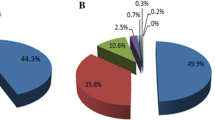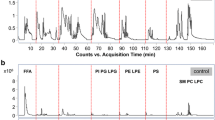Abstract
Abnormal lipid metabolism is a common feature in most solid tumors, and occurs in early stages of the tumor progression. As benign breast tumor is different from malignant tumor of breast cancer, it is particularly important to take benign breast tumor into consideration when investigating cancer biomarkers. In this study, by using a normal-phase/reversed-phase two-dimensional liquid chromatography-mass spectrometry (NP/RP 2D LC-MS) method, we conducted comprehensive lipid profiling in human plasma obtained from six benign breast tumor patients and five breast cancer patients, as well as nine healthy controls. As a result, 512 lipid species were successfully identified. Principal component analysis allowed clear separation of the three groups. Quantitative analysis revealed that many lipid contents were similar in benign and malignant breast tumors compared with controls, and these were proposed as potential breast tumor biomarkers other than breast cancer biomarkers. Two phosphatidylinositol (PI) species, including PI (16:0/16:1) and PI (18:0/20:4), could differentiate between benign and malignant breast tumors, as well as breast cancer patients and healthy controls, indicating that they could be utilized as potential breast cancer biomarkers. In addition, PI (16:0/18:1), phosphatidylglycerol (36:3), and glucosylceramide (d18:1/15:1) were demonstrated to be potential biomarkers to evaluate the level of malignancy of breast tumor. Taken together, our results indicate the usefulness of lipid profiling in the discrimination between patients with breast cancer and non-carcinoma lesions, which might provide assistance in clinical diagnosis.

ᅟ





Similar content being viewed by others
Abbreviations
- BPCs:
-
Base peak chromatograms
- CEF:
-
Compound exchange format
- Cer:
-
Ceramide
- DG:
-
Diacylglycerol
- EICs:
-
Extracted ion chromatograms
- FFA:
-
Free fatty acid
- GalCer:
-
Galactosylceramide
- GCS:
-
Glucosylceramide synthase
- GluCer:
-
Glucosylceramide
- LacCer:
-
Lactosylceramide
- LPC:
-
Lysophosphatidylcholine
- LPE:
-
Lysophosphatidylethanolamine
- LPG:
-
Lysophosphatidylglycerol
- MG:
-
Monoacylglycerol
- MS/MS:
-
Tandem mass spectrometry
- NP/RP 2D LC-MS:
-
Normal-phase/reversed-phase two-dimensional lipid chromatography-mass spectrometry
- PC:
-
Phosphatidylcholine
- PCA:
-
Principal component analysis
- PE:
-
Phosphatidylethanolamine
- PG:
-
Phosphatidylglycerol
- PI:
-
Phosphatidylinositol
- PI3K:
-
Phosphatidylinositol 3-kinase
- PIP3:
-
Phosphatidylinositol-3,4,5-tris-phosphate
- PKC:
-
Protein kinase C
- PS:
-
Phosphatidylserine
- PTEN:
-
Phosphatase and tensin homologue deleted on chromosome 10
- QToF:
-
Quadrupole Time-of-Flight
- SCD1:
-
Stearoyl-CoA desaturase
- SM:
-
Sphingomyelin
- TG:
-
Triacylglycerol
References
Siegel R, Ma JM, Zou ZH, Jemal A (2014) Cancer statistics, 2014. CA Cancer J Clin 64(1):9–29. doi:10.3322/caac.21208
Sasco AJ (2001) Epidemiology of breast cancer: an environmental disease? APMIS 109(5):321–332. doi:10.1034/j.1600-0463.2001.090501.x
Aghaei M, Karami-Tehrani F, Salami S, Atri M (2010) Diagnostic value of adenosine deaminase activity in benign and malignant breast tumors. Arch Med Res 41(1):14–18. doi:10.1016/j.arcmed.2009.10.012
Gross RW, Han XL (2011) Lipidomics at the interface of structure and function in systems biology. Chem Biol 18(3):284–291. doi:10.1016/j.chembiol.2011.01.014
Spener F, Lagarde M, Geloen A, Record M (2003) What is lipidomics? Eur J Lipid Sci Technol 105(9):481–482. doi:10.1002/ejlt.200390101
Oresic M, Hanninen VA, Vidal-Puig A (2008) Lipidomics: a new window to biomedical frontiers. Trends Biotechnol 26(12):647–652. doi:10.1016/j.tibtech.2008.09.001
Doria ML, Cotrim Z, Macedo B, Simoes C, Domingues P, Helguero L, Domingues MR (2012) Lipidomic approach to identify patterns in phospholipid profiles and define class differences in mammary epithelial and breast cancer cells. Breast Cancer Res Treat 133(2):635–648. doi:10.1007/s10549-011-1823-5
Doria ML, Cotrim CZ, Simoes C, Macedo B, Domingues P, Domingues MR, Helguero LA (2013) Lipidomic analysis of phospholipids from human mammary epithelial and breast cancer cell lines. J Cell Physiol 228(2):457–468. doi:10.1002/jcp.24152
Hilvo M, Denkert C, Lehtinen L, Muller B, Brockmoller S, Seppanen-Laakso T, Budczies J, Bucher E, Yetukuri L, Castillo S, Berg E, Nygren H, Sysi-Aho M, Griffin JL, Fiehn O, Loibl S, Richter-Ehrenstein C, Radke C, Hyotylainen T, Kallioniemi O, Iljin K, Oresic M (2011) Novel theranostic opportunities offered by characterization of altered membrane lipid metabolism in breast cancer progression. Cancer Res 71(9):3236–3245. doi:10.1158/0008-5472.can-10-3894
Kim H, Min HK, Kong G, Moon MH (2009) Quantitative analysis of phosphatidylcholines and phosphatidylethanolamines in urine of patients with breast cancer by nanoflow liquid chromatography/tandem mass spectrometry. Anal Bioanal Chem 393(6–7):1649–1656. doi:10.1007/s00216-009-2621-3
Min HK, Kong G, Moon MH (2010) Quantitative analysis of urinary phospholipids found in patients with breast cancer by nanoflow liquid chromatography-tandem mass spectrometry: II. Negative ion mode analysis of four phospholipid classes. Anal Bioanal Chem 396(3):1273–1280. doi:10.1007/s00216-009-3292-9
Hilvo M, Oresic M (2012) Regulation of lipid metabolism in breast cancer provides diagnostic and therapeutic opportunities. Clin Lipidol 7(2):177–188. doi:10.2217/clp.12.10
Schiffmann S, Sandner J, Birod K, Wobst I, Angioni C, Ruckhaberle E, Kaufmann M, Ackermann H, Lotsch J, Schmidt H, Geisslinger G, Grosch S (2009) Ceramide synthases and ceramide levels are increased in breast cancer tissue. Carcinogenesis 30(5):745–752. doi:10.1093/carcin/bgp061
Shah FD, Shukla SN, Shah PM, Patel HRH, Patel PS (2008) Significance of alterations in plasma lipid profile levels in breast cancer. Integr Cancer Ther 7(1):33–41. doi:10.1177/1534735407313883
Nie HG, Liu RR, Yang YY, Bai Y, Guan YF, Qian DQ, Wang T, Liu HW (2010) Lipid profiling of rat peritoneal surface layers by online normal- and reversed-phase 2D LC QToF-MS. J Lipid Res 51(9):2833–2844. doi:10.1194/jlr.D007567
Li M, Yang L, Bai Y, Liu HW (2014) Analytical methods in lipidomics and their applications. Anal Chem 86(1):161–175. doi:10.1021/ac403554h
Li M, Zhou ZG, Nie HG, Bai Y, Liu HW (2011) Recent advances of chromatography and mass spectrometry in lipidomics. Anal Bioanal Chem 399(1):243–249. doi:10.1007/s00216-010-4327-y
Li M, Feng BS, Liang Y, Zhang W, Bai Y, Tang W, Wang T, Liu HW (2013) Lipid profiling of human plasma from peritoneal dialysis patients using an improved 2D (NP/RP) LC-QToF MS method. Anal Bioanal Chem 405(21):6629–6638. doi:10.1007/s00216-013-7109-5
Li M, Tong XL, Lv P, Feng BS, Yang L, Wu Z, Cui XJ, Bai Y, Huang YN, Liu HW (2014) Lipid profiling reveals galactosylceramides increasing in plasma of atherosclerotic stroke patients by online 2D LC QToF-MS. J Chromatogr A 1372:110–119
Fabian H, Lasch P, Boese M, Haensch W (2003) Infrared microspectroscopic imaging of benign breast tumor tissue sections. J Mol Struct 661:411–417. doi:10.1016/j.molstruc.2003.07.002
Bligh EG, Dyer WJ (1959) A rapid method of total lipid extraction and purification. Can J Biochem Physiol 37(8):911–917
Nishizuka Y (1995) Protein kinase C and lipid signaling for sustained cellular-responses. FASEB J 9(7):484–496
Deacon EM, Pettitt TR, Webb P, Cross T, Chahal H, Wakelam MJO, Lord JM (2002) Generation of diacylglycerol molecular species through the cell cycle: a role for 1-stearoyl, 2-arachidonyl glycerol in the activation of nuclear protein kinase C-beta II at G2/M. J Cell Sci 115(5):983–989
Li YL, Su X, Stahl PD, Gross ML (2007) Quantification of diacylglycerol molecular species in biological samples by electrospray ionization mass spectrometry after one-step derivatization. Anal Chem 79(4):1569–1574. doi:10.1021/ac0615910
Grunt TW, Mariani GL (2013) Novel approaches for molecular targeted therapy of breast cancer: interfering with PI3K/AKT/mTOR signaling. Curr Cancer Drug Targets 13(2):188–204
Vara JAF, Casado E, de Castro J, Cejas P, Belda-Iniesta C, Gonzalez-Baron M (2004) PI3K/Akt signalling pathway and cancer. Cancer Treat Rev 30(2):193–204. doi:10.1016/j.ctrv.2003.07.007
Cui WL, Cai Y, Zhou XY (2014) Advances in subunits of PI3K class I in cancer. Pathology 46(3):169–176. doi:10.1097/pat.0000000000000066
Bachman KE, Argani P, Samuels Y, Silliman N, Ptak J, Szabo S, Konishi H, Karakas B, Blair BG, Lin C, Peters BA, Velculescu VE, Park BH (2004) The PIK3CA gene is mutated with high frequency in human breast cancers. Cancer Biol Ther 3(8):772–775
Isakoff SJ, Engelman JA, Irie HY, Luo J, Brachmann SM, Pearline RV, Cantley LC, Brugge JS (2005) Breast cancer-associated PIK3CA mutations are oncogenic in mammary epithelial cells. Cancer Res 65(23):10992–11000. doi:10.1158/0008-5472.can-05-2612
Jiang BH, Liu LZ (2008) PI3K/PTEN signaling in tumorigenesis and angiogenesis. BBA Proteins Proteomics 1784(1):150–158. doi:10.1016/j.bbapap.2007.09.008
Ghayad SE, Cohen PA (2010) Inhibitors of the PI3K/Akt/mTOR pathway: new hope for breast cancer patients. Recent Patents Anti-Cancer Drug Discov 5(1):29–57
Ryland LK, Fox TE, Liu X, Loughran TP, Kester M (2011) Dysregulation of sphingolipid metabolism in cancer. Cancer Biol Ther 11(2):138–149. doi:10.4161/cbt.11.2.14624
Liu YY, Han TY, Giuliano AE, Cabot MC (2001) Ceramide glycosylation potentiates cellular multidrug resistance. FASEB J 15(3):719–730. doi:10.1096/fj.00-0223com
Morjani H, Aouali N, Belhoussine R, Veldman RJ, Levade T, Manfait M (2001) Elevation of glucosylceramide in multidrug-resistant cancer cells and accumulation in cytoplasmic droplets. Int J Cancer 94(2):157–165. doi:10.1002/ijc.1449
Liu YY, Patwardhan GA, Xie P, Gu X, Giuliano AE, Cabot MC (2011) Glucosylceramide synthase, a factor in modulating drug resistance, is overexpressed in metastatic breast carcinoma. Int J Oncol 39(2):425–431. doi:10.3892/ijo.2011.1052
Liu YY, Han TY, Giuliano AE, Cabot MC (1999) Expression of glucosylceramide synthase, converting ceramide to glucosylceramide, confers adriamycin resistance in human breast cancer cells. J Biol Chem 274(2):1140–1146. doi:10.1074/jbc.274.2.1140
Gouaze V, Liu YY, Prickett CS, Yu JY, Giuliano AE, Cabot MC (2005) Glucosylceramide synthase blockade down-regulates P-glycoprotein and resensitizes multidrug-resistant breast cancer cells to anticancer drugs. Cancer Res 65(9):3861–3867. doi:10.1158/0008-5472.can-04-2329
Lucci A, Cho WI, Han TY, Giuliano AE, Morton DL, Cabot MC (1998) Glucosylceramide: a marker for multiple-drug resistant cancers. Anticancer Res 18(1B):475–480
Acknowledgment
This study was financially supported by the National Natural Science Foundation of China (grant no. 21175005).
Author information
Authors and Affiliations
Corresponding authors
Additional information
Published in the topical collection Lipidomics with guest editor Michal Holčapek.
Li Yang and Xinge Cui contributed equally to this work.
Electronic supplementary material
Below is the link to the electronic supplementary material.
ESM 1
(PDF 52 kb)
Rights and permissions
About this article
Cite this article
Yang, L., Cui, X., Zhang, N. et al. Comprehensive lipid profiling of plasma in patients with benign breast tumor and breast cancer reveals novel biomarkers. Anal Bioanal Chem 407, 5065–5077 (2015). https://doi.org/10.1007/s00216-015-8484-x
Received:
Revised:
Accepted:
Published:
Issue Date:
DOI: https://doi.org/10.1007/s00216-015-8484-x




